|
On
the afternoon drive we started out along the river. We noticed
that most of the campsites were now full. We passed an elephant
grazing right in front of one of the campsites, with two men,
presumably weekenders, sitting complacently in lawn chairs
watching them.
We never tired of seeing the
animals; another elephant, a waterbuck by the river, zebras and
wildebeests. A crocodile was sunning himself on the riverbank,
enormous and totally sinister-looking. In the water the hippos
were mock fighting and yawning, showing off their impressive
dagger-like teeth. A mother hippo and her baby were out grazing,
and we watched as they glided back into the water.
A number of hippopotami were walking along beside the river, with
dozens of oxpeckers riding on their backs. Some of the hippos were
carrying a considerable amount of duckweed on their backs; one
could see how they spread this invasive plant from pool to pool.
We were surprised to see so many hippos out of the water in the
daytime, and it was great to get a good look at them on land.
We
crossed a forest of dead trees, likely the work of elephants. The
impala were playing; one stood sentinel on a termite mound while
the others ran back and forth, playfully leaping in the air. A big
male brought up the rear; he was thinner than the others – Gee
said he was so busy patrolling that he didn’t have much time to
eat. A kudu bull stood watching. A family of zebras made their way
among the silvery trunks - a mother with the youngest baby we had
seen, along with another female that appeared very pregnant.
A
troop of baboons passed by, loose-limbed and athletic. Baboons and
impala are friends, Gee told us; baboons have very good eyesight
to watch for predators, and impala have a very keen sense of
smell, so they warn each other of danger. It
seemed an unlikely partnership.
|
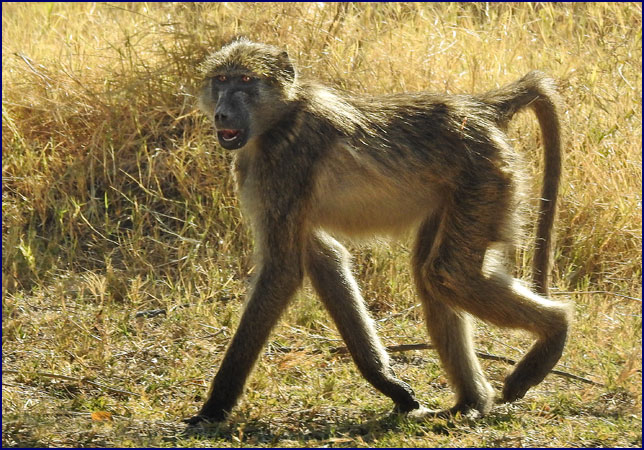
Baboon |
We were looking
for leopard in the camelthorn acacia trees, hoping to find one
sleeping on a horizontal branch. The mind plays tricks; soon I was
seeing them in every tree. A pair of elegant wattled cranes waded
in the shallow water. Two attractive green Meyer’s parrots
hopped along on the ground, foraging for food. Jineen had started
keeping track of how many roller birds we saw; she was up to 12
for the day. I managed to get my first decent in-flight photo of
one.
|
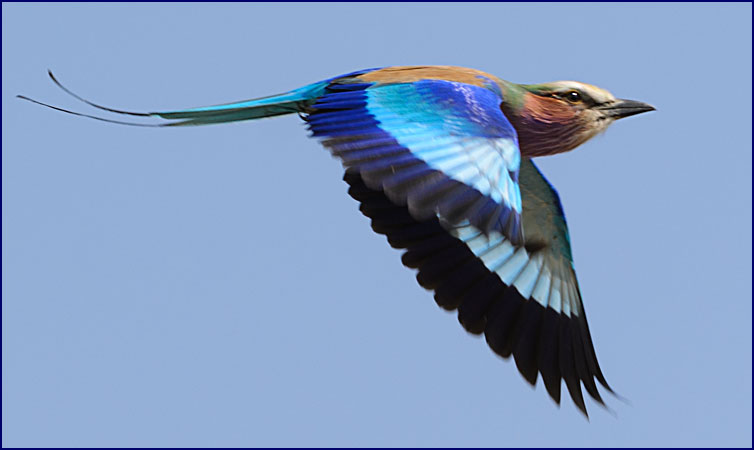
Lilac-breasted Roller in flight!
|
We
were heading west, squinting into the bright sun. The air was
very clear; there was no haze along the horizon like we had
noticed in Chobe. But we did see some smoke in the distance, great
clouds of it coming up from some large fire.
There was a gleam of ivory in the
sun; an elephant, hidden in the trees. Only his tusks showed, the
rest of him was invisible in the shadows. We were constantly
amazed at how quickly and thoroughly elephants can vanish into the
trees - one moment there is this huge beast standing there, and a
few seconds later it will have just disappeared.
There
were kudus on the left and giraffes on the right. A huge bull
elephant blocked the road. Gee thought he might be in musth, with
huge testosterone levels in preparation for mating. This condition
causes them to become very aggressive, so we avoided getting
close.
There was a herd of zebras among
the trees, and we stopped to watch them. Several of them stood
shoulder to shoulder, scratching each other’s necks
companionably. There were two mothers with young foals, still with
fuzzy baby coats. I can’t help but love these charming relatives
of the horse.
Gee
was particularly fascinated with the difference in the zebras’
stripe patterns, and repeatedly commented on the variations.
‘This one has a Z on his shoulder,’ he would point out, ‘and
see how that one has a W on his flank.’ I was equally enthralled
with their diversity. ‘Some of them are white with black
stripes,’ George joked, ‘while others are black with white
stripes.’ But really, some of them did seem to have more white
and others more black. We noticed that they all had faint brown
stripes within the white – these are called shadow stripes, and
are specific to the Burchall’s zebra, and one way to distinguish
them from other types.
As
dusk fell we followed a pair of spotted hyenas. Gee told us that a
group of hyenas is called a clan. The females are larger than the
males. Hyenas are known as scavengers, but they also do hunt. Like
other long distance runners, they have longer front legs than
rear; giraffes, tsessebe and hartebeest share this trait. The
female hyena chooses her mate, and she will fight to keep him.
Several mothers might have babies around the same time, and any of
the adults will bring food to the young ones. They all have
mottled coats, but the younger ones have more pronounced spots.
Gee gave us a wealth of information on all of the animals, and as
the trip went on we were able to retain more of it.
|
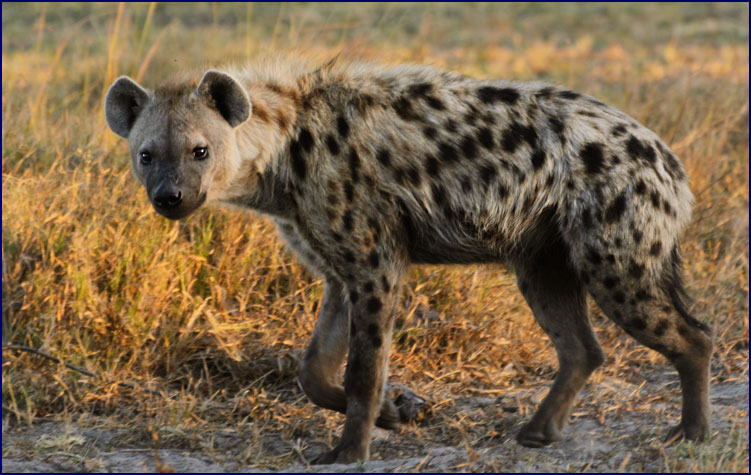
Spotted Hyena |
We
stopped by a waterhole for Sundowners. The sky turned to pink and
rose, and Venus and Jupiter hung low in the sky. As we sipped our
wine we could hear the quiet whooping of the hyenas we had
followed, and watched as another walked along the far shore in the
fading light.
The pink color of the sky was
reflected in the water, with hippos in dark silhouette against it.
George wanted that picture of a hippo holding the setting sun in
his mouth like a ball - this might be his chance! The sun sets
quickly near the equator and darkness falls swiftly – the
opposite of northern lands where the sun moves horizontally along
the skyline. The most vibrant colors filled the sky after the sun
had gone down.
Gee
cautioned us not to go close to the edge of the water because the
hippos might charge. Though they appear slow, he told us, they are
actually very fast. ‘They will put your whole head and upper
torso in their mouth, crunch you, and then spit you out,’ he
said. It sounded a particularly unpleasant way to die.
We left the waterhole just before
it was fully dark, passing a spot by the river where elephants
were silhouetted against the last dim light of sunset. There was
not enough light for me to take photos, but Nick got some with his
magic camera that sees in the dark. Gee stopped for us to look and
just listen. The moon was not up yet, rising later each night;
without its interference the stars came out one by one. The night
sky was brilliant, with Scorpius and the diamond shape of the
Southern Cross high overhead.
We were heading home,
spotlighting. Suddenly Gee stopped and exclaimed ‘Look at the
genet!’ But in the next breath, he added, ‘Look at the African
wildcat!’ Sure
enough, both were there in the same spot. The sleek-bodied genet
was clinging to a tree trunk, its long striped tail hanging down.
Nearby an African wildcat, ancestor to modern house cats, darted
quickly into the brush.
|
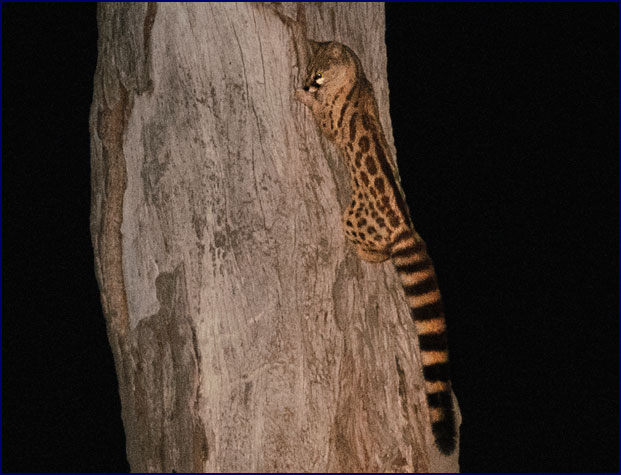
Genet
|
A
few minutes later Gee stopped again in amazement. ‘There is a
bushbaby!’ And sure enough, there one was, in a small tree near
the road. Gee had spied him by his glowing eyes in the spotlight.
This tiny primate was impossibly cute, with huge eyes and a long
tail. This was amazing; almost all of our wishes had come true.
Lions and leopards with a kill, a giraffe drinking, wild dogs
hunting, and now Nick’s bushbaby. Apparently all we had to do
was ask for it out loud.
Back at camp I took photos of a fiery moon coming up through the
tree branches, one night past full, rising later than the night
before. We could see the stars among the trees as we sat around
the campfire. Gee told us more about ‘traditional doctors,’
which some would call witch doctors. They use herbs for healing,
but also depend on spiritual rituals and muti,
the traditional magic-based medicines. They can lift a spell or
curse, or they can place one on somebody. Now more people in
Botswana go to modern medical professionals, but some still depend
on these traditional doctors who practice in the ancient way.
It was another wonderful dinner;
how did these guys do it?
August
2
It was moving day again; we
were up at 5:30 and on the road before first light, leaving the
guys packing up the tents. We were sorry to say goodbye to our
beautiful Khwai camp. An elephant stood by the road to see us off
as we drove toward a beautiful sunrise.
The usuals were out; several
waterbucks stood in the wispy yellow grass and a family of
warthogs grazed nearby, kneeling to better reach their breakfast.
Gee told us that the waterbuck have glands that secrete a
substance when chased that makes them taste really bad, therefore
making them undesirable for predators to hunt. Squirrels ran up
and down the tree trunks.
|
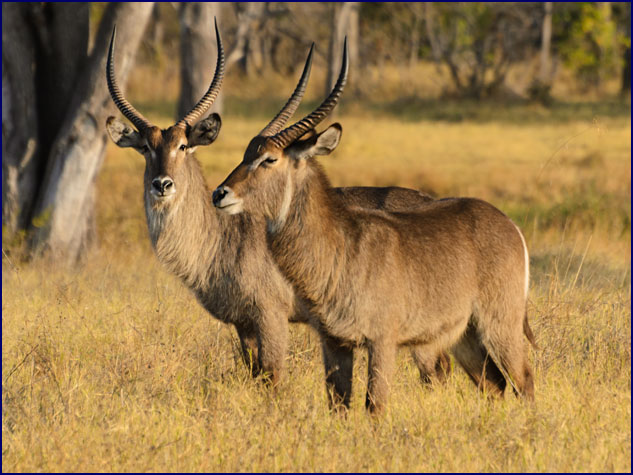
Waterbucks
|
We
passed four tsessebe, built for speed – Gee told us they are the
fastest of the antelopes, and can outrun a horse over distance.
Zebras and giraffes browsed beside the road; Gee said they like to
hang out together because the zebras can see what is low in the
bushes, and the giraffes can keep watch from high up. Giraffes
keep their heads up even when they lay down to sleep, and so even
then can see much further than the zebras can.
|
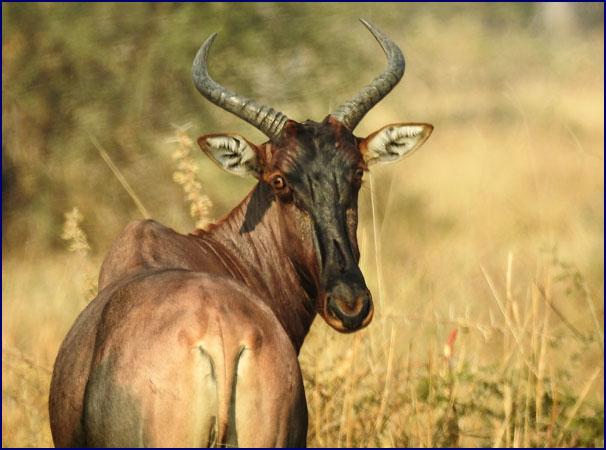
Tsessebe |
A
pale moon hung low in the sky. A pair of Meyer’s parrots perched
in a tree, and then flew off displaying the brilliant turquoise
blue color on their backs. A spurfowl with small chicks hurried
along beside the road. We could see a brown snake eagle flying
overhead.
|
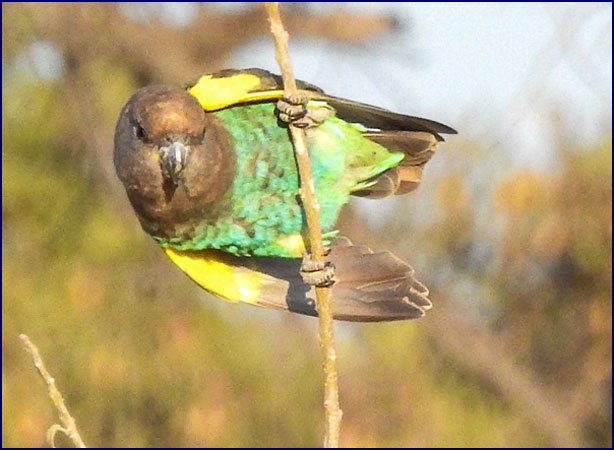
Meyer's Parrot |
Gee
told us about some of the different trees. We passed through an
area where many dead trees with silvery trunks stood; these were
leadwood trees, and the wood is very hard and heavy - they stand
for fifty years or more after they are dead. The mopane trees were
everywhere, short and stunted from the elephants eating them. The
rain trees are laden with thousands of hanging seed pods; the
noise the pods make in the breeze sounds like rain, hence the
name. We passed a newly flooded area with trees growing out of the
shallow water – Gee said they will die if the water stays for
long.
We drove alongside the Khwai
River for a while, crossing several shallow streams. There was a
large barren area of elephant devastation, where the trees had
been killed from them stripping the bark. We passed by a hyena
den, but nobody was home. We saw some calcified hyena dung; it is
bleached pure white in the sun because of the high calcium content
from eating bones. Further on Gee pointed out a deep burrow,
probably the home of an aardvark.
A large zebra herd loitered near
the road; several of them were busy kicking one another. We could
hear them calling out in a high pitched voice, somewhere between a
small dog yipping and a donkey braying. Like many of the animals
in Africa, the noise the zebras make does not sound like what you
would expect.
We
came to a large area that had been recently burned; it was huge,
many hundreds of acres. We realized that this was the source of
the smoke we had seen near the horizon the day before. The ground
was completely charred black, and in many places the trees and
ashes were still smoldering. We passed several logs still burning
with open flames - we were surprised that no efforts were being
made to put the fire out. But when we thought about it, who was
there to put it out? It’s not like one could call the local fire
department. It seemed like a devastating thing to me, but Gee told
us that occasional fires are an important part of nature’s
cycle. Most of the animals are able to flee and escape the flames,
and the fires clear the land and make way for new growth.
The underbrush was all burned
away, but it appeared that most of the larger trees would survive.
It was surprising to see how the narrow sand road had acted as a
firebreak; it had burned right up to one side of the road but not
crossed over. Surprisingly, many of the animals seemed to love the
aftermath of the fire. Gee said they liked certain minerals they
found in the burned areas, but I thought perhaps they just wanted
a cooked lunch. Elephants and buffalo stood in the black charred
forest by the dozen eating the burnt shrubs, and lilac-breasted
rollers and hornbills were everywhere. Jineen was still counting
roller birds; she’d had 14 yesterday, and was already up to 23
so far today.
We
stopped for tea along the river, and Gee changed a flat tire on
the luggage trailer. Then we came to a more-traveled dirt road and
followed it through the Khwai village. There were many small homes
with thatched roofs, some clustered together and others far apart,
and most had stockade-type fences around them. Some of the houses
were tidy little round cottages, and others were unkempt shacks. A
compound of buildings painted pink and blue was lodging for the
government officials when they visit the village. There were
several rickety shops beside the road, and a few of the local
people were moving about. We passed a kgotla,
a round stockade used as a traditional tribal court. Gee stopped
at a friend’s house to return the rifle which he had borrowed
for our bush walk, and learned that a pride of lions had been seen
walking through the village earlier that morning.
Gee told us about the Khwai
village. The whole area used to belong to the San people, also
known as Bushmen. Their society is based on hunting and gathering,
and they do not farm. When
the Moremi Park was formed in 1963 the Bushmen were pushed out of
their homes in Moremi and into the Khwai village, which is inside
the park where hunting is not permitted. Originally the Bushmen
were allowed to hunt for food within strict limitations, but they
were found to be killing too many animals and selling the meat -
so the government said no more hunting. Instead the Bushmen were
given the concession for tourism. The Khwai Community area gets
revenue from safaris and campers; each family gets 500 pula per
month to live on, equal to about US $55. They also can cut and
sell the dried grasses used for thatching roofs, and they have the
opportunity to be hired in the safari camps.
|
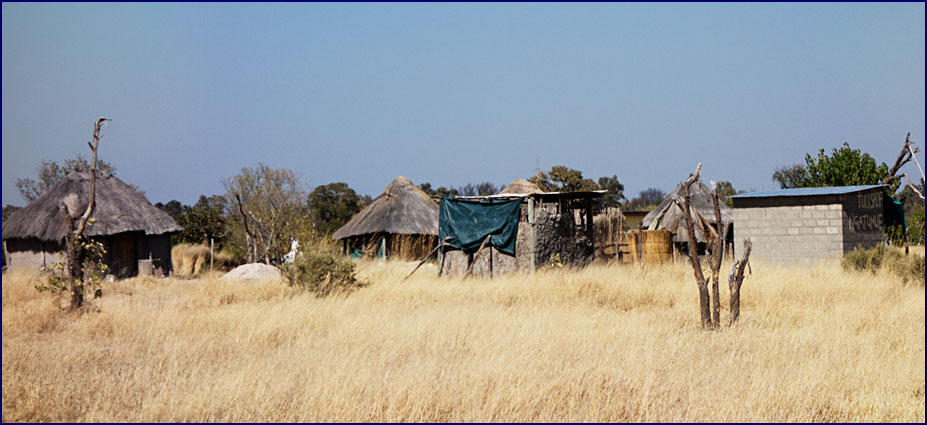
Khwai Village
|
Since
Khwai is inside the park the Bushmen are not allowed to build
schools there, though they can build preschools, Gee explained.
Now the government is pressuring the people to move out of Khwai
and closer to the schools; many families have a place to stay in
Maun so that the children can attend school. They are not allowed
to keep livestock in the Khwai village because it attracts
leopards. They are also not supposed to have dogs for the same
reason, but we actually did see quite a few dogs about. The people
do not walk through the town at night because of the danger from
lions, leopards and hippos.
Gee belongs to the Bayei tribe,
the largest in the Okavango Delta. Tribes can and often do
intermarry. We asked Gee if he spoke Bushmen, and he replied with
an impressive stream of the unintelligible sounds and clicks that
make up the language. Translating, he told us he had just asked
for some water to drink - and that was all he knew how to say!
We were looking for the lions that
had walked through the village - Gee left the road and followed a
narrow track through the bush hoping to find them. We encountered
a local woman out cutting grass for thatch with a sickle, and she
told us where the lions had last been seen. Even though they had
been very near, she did not seem in the least afraid of being out
there alone. Gee asked her permission for us to photograph her,
for which we paid her a couple of dollars.
After
searching for a while we gave up on finding the lions and
continued on our way. Presently we came to a long and somewhat
shaky wooden bridge across the Khwai River. ‘Slow Down on top of the Bridge,’ a sign instructed us, and indeed,
it didn’t look like one you wanted to go too fast on. Gee had us
get out and walk across while he drove the vehicle; we were not
sure if this was for safety, or just to be sure we got the full
experience. The remains of a much older bridge stood just to the
right of the one we were on. We asked Gee if this was the famous Bridge
over the River Kwai from the movie and he assured us it was -
but later we learned that he was just pulling our leg; the WW2
version was actually in Thailand.
|
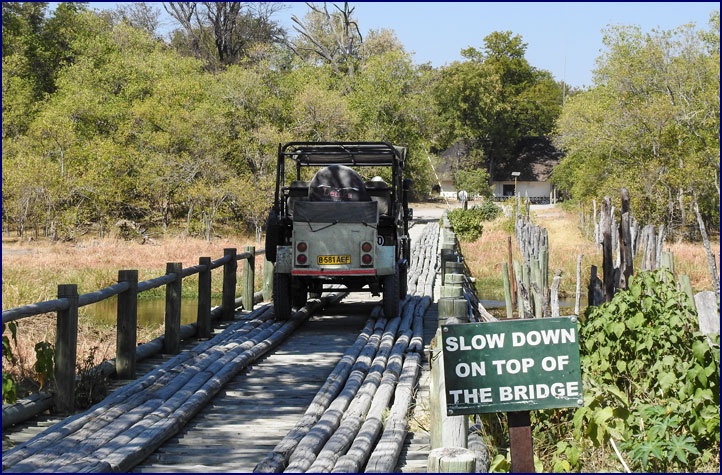
Bridge over the
River Khwai
|
We
came to the Moremi Game Reserve gate. While Gee signed us in, a
little squirrel poked its head out from above the rafters of the
gate building and peered down at us, no doubt welcoming us to the
Okavango Delta. Being part of the Kalahari Desert system the
region is dry much of the year, but the rains that fall in Angola,
thousands of miles to the north, flood the delta annually. It
takes six months for the waters to get there, coinciding with the
dry season, so the wildlife is concentrated in the delta area when
it is flooded - this makes July and August a great time to visit
the Okavango. Also since it is the African winter the weather is
pleasant (it can be very hot in Botswana in the summer), and there
are very few insects. I did not see a single mosquito the whole
trip.
We continued on, driving down deep
sand roads. A small herd of red lechwe walked through the marsh.
These reddish-brown antelope look a bit like impala at first
glance, only larger and stockier. They are built downhill, with
their front legs considerably shorter than their hind. Gee told us
that they run into the water to escape predators, and that they
have webbed feet and can jump like a kangaroo. (He may have been
having us on a little with those last bits) They run with their
heads low, and have powerful hindquarters for leaping and plunging
through the shallow water. They primarily live in the Okavango
Delta, where they are more numerous than even impala.
|
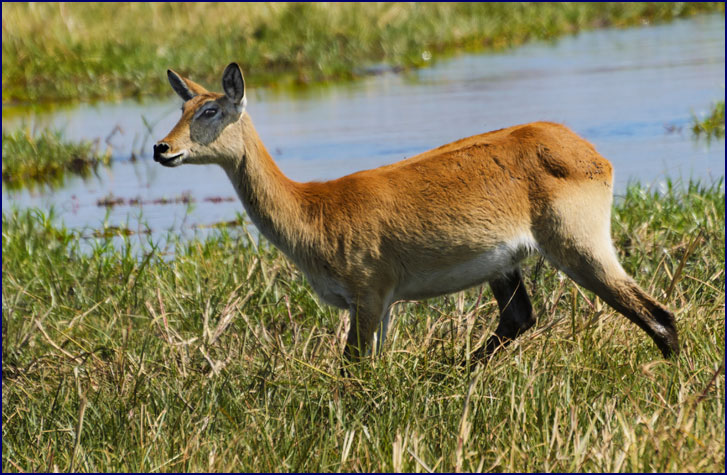
Red Lechwe |
We
got a close look at several large male warthogs with impressive
knobby protrusions on the side of their faces; we learned that
these are to protect their eyes when they fight, so only the males
have them. We passed more elephants, and Gee pointed out a female
near the road with a wet patch behind her eye - this is a gland
that weeps when they are stressed. The elephants’ earhole is at
the front of the ears, not behind the flaps like you might expect.
I really loved learning about the wildlife from Gee; he was giving
us more and more information as the trip went on. He seemed to
enjoy our enthusiasm; he said some guests are not interested in
anything other than seeing lions.
Hartlaub’s babblers sung from
the trees, and a bateleur eagle looked down at us from his perch
high in a tree. I continued in my efforts to photograph a roller
in flight; I still got my share of twig photos, but I was getting
better at it.
We
stopped for lunch at the Dombo Hippo pools, a large lagoon or
reservoir. There was a blind up on a high platform, with a sign on
the steps warning, ‘Be
Careful, the stairs are not sturdy! ‘ I climbed the
staircase for a look, and sure enough the sign was correct.
We sat in our camp chairs by the
water and ate lunch, watching the wildlife around us. A raft of
hippos slept on the shore not far away. Some of the collective
nouns for African animals seem obscure - a leap
of leopards or a dazzle of
zebra - but a group of hippos all sleeping side by side really
does look quite a bit like a raft. A mother and her baby got up
from the group and glided into the water together.
On
the far side of the reservoir a herd of elephants stood along the
shore drinking. Several more groups arrived as we watched; soon
there were over 100 of them. There were a number of families with
babies, and a couple of hippos grazed among them. Several of the
elephants took a mud bath; they seemed to be having a great time
taking turns wallowing in a big mudhole – we called it the elephant
spa. Then after a while the elephants turned and left, one group
at a time, quickly melting into the brush – soon there were none
left in sight.
Parrots flew among the trees, and
herons and egrets waded near the shore. A group of red lechwe came
to drink, and one of the bucks lay down for a rest about a hundred
feet from us. A hippo glided smoothly across the reservoir; we
couldn’t tell if he was swimming or walking on the bottom. A
fish eagle gave his high-pitched mournful cry as he flew across
over the water.
|
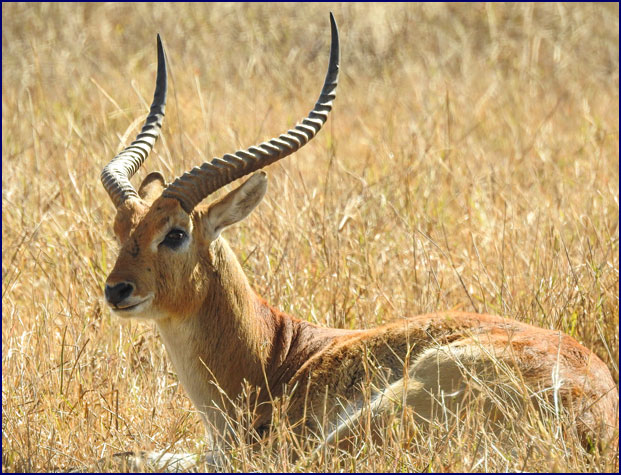
Red Lechwe |
After
an hour and a half lunchbreak, we moved on. The road wound through
a lovely forest of huge mopane trees; we hadn’t realized they
grew so tall when the elephants didn’t eat them down. There was
little underbrush but many felled trees on the ground - I wanted
to gallop a horse through the forest and jump the logs.
|